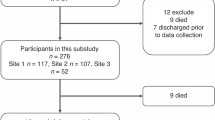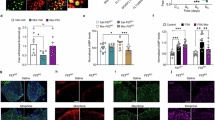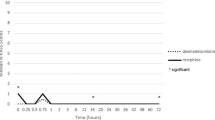Abstract
Despite mounting evidence on the importance of pain management in preterm infants, clinical use of analgesics in this population is limited. Our previous studies have shown that neonatal inflammation results in long-term alterations in adult somatosensory thresholds, characterized by decreased baseline nociceptive sensitivity, and enhanced hyperalgesia after a subsequent inflammatory insult. The present studies were conducted to determine whether preemptive morphine attenuates these negative consequences. At P0, pups received an injection of morphine sulfate before an intraplantar injection of 1% carrageenan. Control pups received either saline (SAL) followed by intraplantar carrageenan, morphine sulfate followed by intraplantar SAL, or SAL followed by intraplantar SAL. Preemptive morphine significantly attenuated neonatal injury-induced hypoalgesia in adolescence and adulthood. Similarly, morphine pretreated animals displayed significantly less hyperalgesia and recovered faster from a subsequent inflammatory insult compared with controls. Neonatal morphine had no significant effect on morphine analgesia in adulthood. Interestingly, neonatally injured animals that did not receive morphine displayed a significant rightward shift in the morphine dose-response cuve in the absence of peripheral inflammation. Together, these results demonstrate that preemptive morphine significantly attenuates the long-term behavioral impact of neonatal inflammatory injury.
Similar content being viewed by others
Log in or create a free account to read this content
Gain free access to this article, as well as selected content from this journal and more on nature.com
or
Abbreviations
- CFA:
-
Complete Freund's adjuvant
- CGN:
-
carrageenan
- MDS:
-
mean difference score
- MOR:
-
mu opioid receptor
- MOR-LI:
-
mu opioid receptor-like immunoreactivity
- MS:
-
morphine sulfate
- P:
-
postnatal day
- PWL:
-
paw withdrawal latency
- SAL:
-
saline
References
Tibboel D, Anand KJ, van den Anker JN 2005 The pharmacological treatment of neonatal pain. Semin Fetal Neonatal Med 10: 195–205
Andrews K, Fitzgerald M 1999 Cutaneous flexion reflex in human neonates: a quantitative study of threshold and stimulus-response characteristics after single and repeated stimuli. Dev Med Child Neurol 41: 696–703
Smith RP, Gitau R, Glover V, Fisk NM 2000 Pain and stress in the human fetus. Eur J Obstet Gynecol Reprod Biol 92: 161–165
Giannakoulopoulos X, Teixeira J, Fisk N, Glover V 1999 Human fetal and maternal noradrenaline responses to invasive procedures. Pediatr Res 45: 494–499
Anand KJ, Carr DB 1989 The neuroanatomy, neurophysiology, and neurochemistry of pain, stress, and analgesia in newborns and children. Pediatr Clin North Am 36: 795–822
Franck LS, Greenberg CS, Stevens B 2000 Pain assessment in infants and children. Pediatr Clin North Am 47: 487–512
McNair C, Ballantyne M, Dionne K, Stephens D, Stevens B 2004 Postoperative pain assessment in the neonatal intensive care unit. Arch Dis Child Fetal Neonatal Ed 89: F537–F541
Slater R, Cantarella A, Gallella S, Worley A, Boyd S, Meek J, Fitzgerald M 2006 Cortical pain responses in human infants. J Neurosci 26: 3662–3666
Bartocci M, Bergqvist LL, Lagercrantz H, Anand KJ 2006 Pain activates cortical areas in the preterm newborn brain. Pain 122: 109–117
Grunau RV, Whitfield MF, Petrie JH 1994 Pain sensitivity and temperament in extremely low-birth-weight premature toddlers and preterm and full-term controls. Pain 58: 341–346
Bhutta AT, Cleves MA, Casey PH, Cradock MM, Anand KJ 2002 Cognitive and behavioral outcomes of school-aged children who were born preterm: a meta-analysis. JAMA 288: 728–737
Lidow MS, Song ZM, Ren K 2001 Long-term effects of short-lasting early local inflammatory insult. Neuroreport 12: 399–403
LaPrairie JL, Murphy AZ 2007 Female rats are more vulnerable to the long-term consequences of neonatal inflammatory injury. Pain 132: S124–S133
Grunau RE, Oberlander TF, Whitfield MF, Fitzgerald C, Lee SK 2001 Demographic and therapeutic determinants of pain reactivity in very low birth weight neonates at 32 Weeks' postconceptional Age. Pediatrics 107: 105–112
Oberlander TF, Grunau RE, Whitfield MF, Fitzgerald C, Pitfield S, Saul JP 2000 Biobehavioral pain responses in former extremely low birth weight infants at four months' corrected age. Pediatrics 105: e6
Wang G, Ji Y, Lidow MS, Traub RJ 2004 Neonatal hind paw injury alters processing of visceral and somatic nociceptive stimuli in the adult rat. J Pain 5: 440–449
Bhutta AT, Rovnaghi C, Simpson PM, Gossett JM, Scalzo FM, Anand KJ 2001 Interactions of inflammatory pain and morphine in infant rats: long-term behavioral effects. Physiol Behav 73: 51–58
Anand KJ, Hickey PR 1992 Halothane-morphine compared with high-dose sufentanil for anesthesia and postoperative analgesia in neonatal cardiac surgery. N Engl J Med 326: 1–9
Yaster M, Deshpande JK 1988 Management of pediatric pain with opioid analgesics. J Pediatr 113: 421–429
Bouwmeester NJ, Anand KJ, van Dijk M, Hop WC, Boomsma F, Tibboel D 2001 Hormonal and metabolic stress responses after major surgery in children aged 0-3 years: a double-blind, randomized trial comparing the effects of continuous versus intermittent morphine. Br J Anaesth 87: 390–399
Bouwmeester NJ, Hop WC, van Dijk M, Anand KJ, van den Anker JN, Tibboel D 2003 Postoperative pain in the neonate: age-related differences in morphine requirements and metabolism. Intensive Care Med 29: 2009–2015
Abbott FV, Guy ER 1995 Effects of morphine, pentobarbital and amphetamine on formalin-induced behaviours in infant rats: sedation versus specific suppression of pain. Pain 62: 303–312
Sternberg WF, Scorr L, Smith LD, Ridgway CG, Stout M 2005 Long-term effects of neonatal surgery on adulthood pain behavior. Pain 113: 347–353
Nandi R, Beacham D, Middleton J, Koltzenburg M, Howard RF, Fitzgerald M 2004 The functional expression of mu opioid receptors on sensory neurons is developmentally regulated; morphine analgesia is less selective in the neonate. Pain 111: 38–50
Hargreaves K, Dubner R, Brown F, Flores C, Joris J 1988 A new and sensitive method for measuring thermal nociception in cutaneous hyperalgesia. Pain 32: 77–88
Morgan MM, Fossum EN, Stalding BM, King MM 2006 Morphine antinociceptive potency on chemical, mechanical, and thermal nociceptive tests in the rat. J Pain 7: 358–366
Wang X, Traub RJ, Murphy AZ 2006 Persistent pain model reveals sex difference in morphine potency. Am J Physiol Regul Integr Comp Physiol 291: R300–R306
Peters JW, Koot HM, de Boer JB, Passchier J, Bueno-de-Mesquita JM, de Jong FH, Duivenvoorden HJ, Tibboel D 2003 Major surgery within the first 3 months of life and subsequent biobehavioral pain responses to immunization at later age: a case comparison study. Pediatrics 111: 129–135
Iadarola MJ, Douglass J, Civelli O, Naranjo JR 1988 Differential activation of spinal cord dynorphin and enkephalin neurons during hyperalgesia: evidence using cDNA hybridization. Brain Res 455: 205–212
Noguchi K, Morita Y, Kiyama H, Sato M, Ono K, Tohyama M 1989 Preproenkephalin gene expression in the rat spinal cord after noxious stimuli. Brain Res Mol Brain Res 5: 227–234
Williams FG, Mullet MA, Beitz AJ 1995 Basal release of Met-enkephalin and neurotensin in the ventrolateral periaqueductal gray matter of the rat: a microdialysis study of antinociceptive circuits. Brain Res 690: 207–216
Goffaux P, Lafrenaye S, Morin M, Patural H, Demers G, Marchand S Preterm births: can neonatal pain alter the development of endogenous gating systems? Eur J Pain, in press
Hermann C, Hohmeister J, Demirakca S, Zohsel K, Flor H 2006 Long-term alteration of pain sensitivity in school-aged children with early pain experiences. Pain 125: 278–285
Cervero F, Plenderleith MB 1985 C-fibre excitation and tonic descending inhibition of dorsal horn neurones in adult rats treated at birth with capsaicin. J Physiol 365: 223–237
Grunau RE, Holsti L, Haley DW, Oberlander T, Weinberg J, Solimano A, Whitfield MF, Fitzgerald C, Yu W 2005 Neonatal procedural pain exposure predicts lower cortisol and behavioral reactivity in preterm infants in the NICU. Pain 113: 293–300
Sternberg WF, Ridgway CG 2003 Effects of gestational stress and neonatal handling on pain, analgesia, and stress behavior of adult mice. Physiol Behav 78: 375–383
Coutinho SV, Plotsky PM, Sablad M, Miller JC, Zhou H, Bayati AI, McRoberts JA, Mayer EA 2002 Neonatal maternal separation alters stress-induced responses to viscerosomatic nociceptive stimuli in rat. Am J Physiol Gastrointest Liver Physiol 282: G307–G316
Pieretti S, d'Amore A, Loizzo A 1991 Long-term changes induced by developmental handling on pain threshold: effects of morphine and naloxone. Behav Neurosci 105: 215–218
Johnston CC, Stevens BJ 1996 Experience in a neonatal intensive care unit affects pain response. Pediatrics 98: 925–930
Peters JW, Schouw R, Anand KJ, van Dijk M, Duivenvoorden HJ, Tibboel D 2005 Does neonatal surgery lead to increased pain sensitivity in later childhood?. Pain 114: 444–454
Morison SJ, Holsti L, Grunau RE, Whitfield MF, Oberlander TF, Chan HW, Williams L 2003 Are there developmentally distinct motor indicators of pain in preterm infants?. Early Hum Dev 72: 131–146
Christie MJ, Trisdikoon P, Chesher GB 1982 Tolerance and cross tolerance with morphine resulting from physiological release of endogenous opiates. Life Sci 31: 839–845
Lett BT, Grant VL, Koh MT, Flynn G 2002 Prior experience with wheel running produces cross-tolerance to the rewarding effect of morphine. Pharmacol Biochem Behav 72: 101–105
Stoller DC, Thornton SR, Smith FL 2002 Loss of antinociceptive efficacy in rat pups infused with morphine from osmotic minipumps. Pharmacology 66: 11–18
Author information
Authors and Affiliations
Corresponding author
Additional information
This work was supported by National Institute of Health grants DA16272 and AR49555 awarded to Anne Z. Murphy, the Center for Behavioral Neuroscience NSF: IBN 9876754, and the Georgia State University Brains and Behavior Program.
Rights and permissions
About this article
Cite this article
Laprairie, J., Johns, M. & Murphy, A. Preemptive Morphine Analgesia Attenuates the Long-Term Consequences of Neonatal Inflammation in Male and Female Rats. Pediatr Res 64, 625–630 (2008). https://doi.org/10.1203/PDR.0b013e31818702d4
Received:
Accepted:
Issue date:
DOI: https://doi.org/10.1203/PDR.0b013e31818702d4
This article is cited by
-
The development of pain circuits and unique effects of neonatal injury
Journal of Neural Transmission (2020)
-
Anesthetics and the Developing Brain: The Yin and Yang
Current Anesthesiology Reports (2015)



